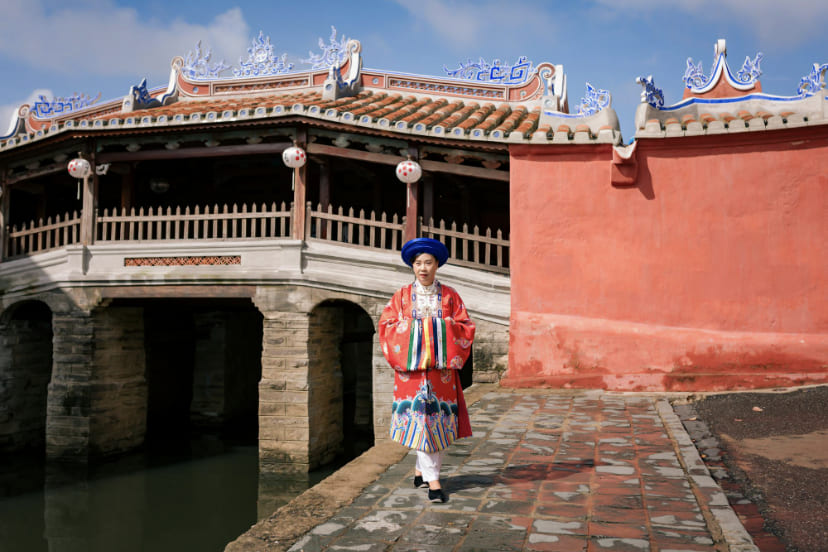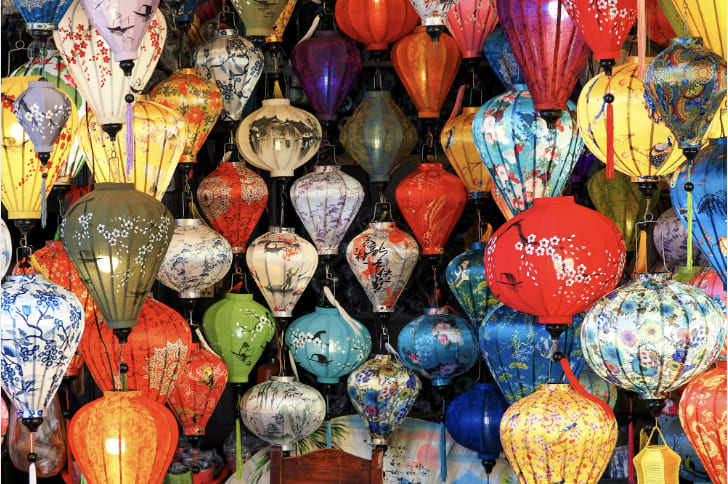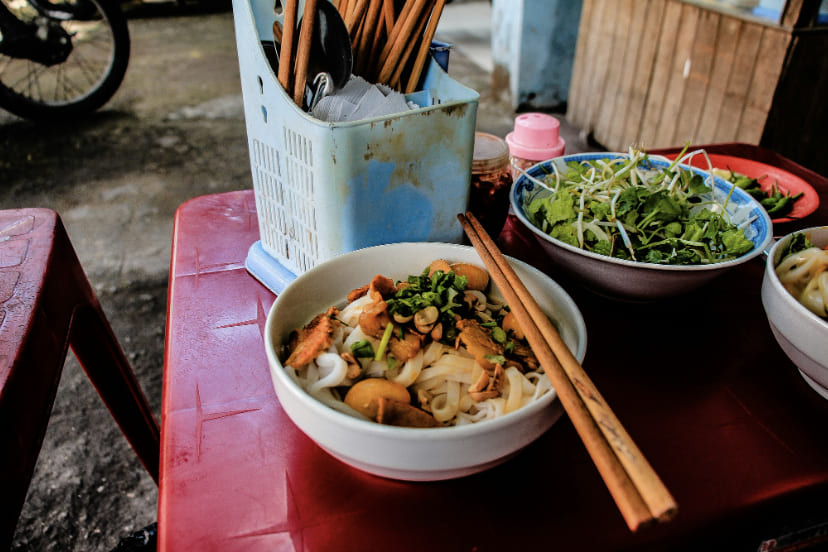📸 Hoi An is a photographer's dream—ancient yellow buildings, thousands of colorful lanterns, vibrant markets, and the golden light reflecting off the Thu Bon River. Whether you're shooting with a smartphone or a professional camera, this guide will help you capture those iconic Instagram-worthy shots (and discover hidden spots nobody else knows about).
📋 What You'll Learn
- Best Times to Shoot in Hoi An
- Japanese Bridge (Iconic Shot)
- Ancient Town Streets at Night
- Lantern Shop Alley
- Thu Bon River Views
- Countryside Rice Paddies
- An Bang Beach Sunrise
- Hidden Photo Spots
- Camera Settings & Technical Tips
- Drone Photography Rules
- Smartphone Photography Tips
- Photography Ethics & Respect
Best Times to Shoot in Hoi An 🌅
The Golden Hours (Most Important!):
- Sunrise: 5:30-7:00 AM (soft light, empty streets, locals starting their day)
- Blue Hour (Morning): 5:00-5:30 AM (magical pre-dawn light)
- Golden Hour (Evening): 5:00-6:30 PM (warm golden light on yellow buildings)
- Blue Hour (Evening): 6:30-7:30 PM (lanterns lit, sky still has color)
- Night: 7:30-10:00 PM (vibrant lantern colors, reflections in river)
Pro tip: The 15-minute window during blue hour (just after sunset) is absolute magic in Hoi An. The lanterns are fully lit, the sky still has deep blue color, and you get both artificial and natural light. This is when you'll capture those viral Instagram shots.
Avoid shooting: 10 AM - 3 PM (harsh overhead light, sweaty tourists everywhere, washed-out colors). If you must shoot midday, stick to shaded alleyways or indoor shots in cafes.
Best day to visit: The Full Moon Lantern Festival (14th day of lunar month) is incredible for photos, but it's also the most crowded. Consider going 1-2 days before or after for similar vibes with fewer people.
1. Japanese Bridge (Chùa Cầu) 🌉
The most iconic shot in Hoi An. This 400-year-old covered bridge is the symbol of the city, draped in lanterns and beautifully lit at night.
Best time: Blue hour (6:30-7:15 PM) or early morning (6:00-7:00 AM before crowds)
Camera settings:
- Night shot: ISO 800-1600, f/2.8-4.0, 1/30-1/60s (use image stabilization or tripod)
- Morning shot: ISO 100-400, f/8-11, 1/125-1/250s
Composition tips:
- Classic frontal shot from Trần Phú Street
- Shoot from inside the bridge looking out (interesting framing)
- Get low angle from riverside with reflection if water is calm
- Include a person in áo dài (traditional Vietnamese dress) for scale and cultural context
Hidden angle: Walk to the small alley immediately after crossing the bridge (Nguyễn Thị Minh Khai). You'll find a quieter angle with fewer tourists and great lantern reflections in shop windows.
GPS coordinates: 15.8795° N, 108.3271° E
2. Ancient Town Streets at Night 🏮
Where: Trần Phú Street, Nguyễn Thái Học, and Bach Đang Street (near the river)
The yellow colonial buildings become golden at night under lantern light, creating those dreamy, warm-toned Instagram shots everyone loves.
Best time: 7:00-9:00 PM (after dark but before tourist restaurants close)
Camera settings:
- ISO 1600-3200 (embrace some grain for authentic street photography feel)
- f/1.8-2.8 (wide aperture for bokeh and lantern orbs)
- 1/60-1/125s (handheld) or slower with tripod
Pro tips:
- Shoot vertical for Instagram Stories/Reels
- Include bicycles or motorbikes for authentic Vietnamese street life
- Capture motion blur of bikes moving through lantern-lit streets
- Frame shots through doorways or windows of cafes
- Use reflections in rain puddles if you're lucky enough to visit after rain
Hidden spot: The small pedestrian alley between Trần Phú and Bach Đang (near #90 Trần Phú) has incredible lantern density with almost no tourists. Perfect for that "private" Hoi An moment.
3. Lantern Shop Alley 🏮✨
Where: Nguyễn Hoàng Street (parallel to river, between Japanese Bridge and An Hoi Bridge)
This narrow alley is completely packed with lantern shops, creating a tunnel of colorful lights. It's Instagram gold.
Best time: 6:30-8:00 PM (blue hour to early night)
Camera settings:
- ISO 800-1600
- f/2.8-4.0
- 1/60-1/125s
- White balance: Auto or Tungsten (cooler tones) for mood
Shot ideas:
- Portrait in front of lantern wall (have friend hold phone flashlight to light face)
- Close-up of single lantern with bokeh background
- Long perspective shot down the alley (use leading lines)
- Silhouette shot with lanterns as backlight
Shopping tip: These shops are also where you can buy lanterns (from 50,000-200,000 VND). They're usually happy for you to pose with lanterns even if you're not buying, but be respectful and maybe buy a small one to say thanks!
GPS: 15.8782° N, 108.3251° E
4. Thu Bon River Views 🛶
Where: Bach Đang Street (riverfront promenade)
The river reflects the colorful lights of Ancient Town, creating stunning mirror images. This is also where you'll see traditional wooden boats and floating lanterns.
Best time: 6:45-7:30 PM (blue hour for best reflections) or 6:00-7:00 AM for sunrise boat shots
Camera settings for reflections:
- ISO 400-800 (keep low for sharper reflections)
- f/8-11 (sharper image throughout)
- Tripod essential (1-4 second exposures for glassy water)
- Use 2-second timer to avoid camera shake
Shot ideas:
- Symmetrical reflection of lantern-lit buildings
- Traditional boat with lanterns in foreground
- Release a floating lantern and photograph it drifting (50,000 VND to buy)
- Long exposure of boats moving (creates light trails from lanterns)
Pro tip: Rent a basket boat for 30 minutes (200,000 VND) and photograph FROM the river looking back at Ancient Town. This is how you get those professional shots without other tourists in the frame. The boat owners will even paddle you to the best angles.
Getting there: Walk along Bach Đang from Japanese Bridge toward An Hoi Bridge. Multiple spots along this 500m stretch offer excellent views.
5. Countryside Rice Paddies 🌾
Where: Cam Thanh Village (15 minutes by bike from Ancient Town)
Emerald green rice paddies with water buffalo, farmers in conical hats, and traditional Vietnamese countryside life. These shots offer contrast to the urban Ancient Town photos.
Best time: 6:00-8:00 AM (soft light, farmers working in fields) or 5:00-6:30 PM (golden hour)
Camera settings:
- ISO 100-400
- f/8-16 (maximize depth of field for landscape)
- 1/125-1/500s
- Use polarizing filter if you have one (deeper blues, greener greens)
Shot ideas:
- Aerial-like perspective from small hill or bridge
- Farmer in conical hat working in field (ask permission first!)
- Water buffalo in paddies
- Palm tree-lined paths between paddies
- Reflection of clouds in flooded paddies
How to get there: Rent a bicycle (30,000 VND/day) or scooter (100,000-150,000 VND/day) and ride east on Trần Quốc Toản Road toward Cam Thanh. Look for small paths leading off the main road into rice fields. See our complete transport guide for rental details and safety tips.
GPS starting point: 15.8942° N, 108.3541° E (Cam Thanh Village entrance)
6. An Bang Beach Sunrise 🌅
Where: An Bang Beach (4km from Ancient Town)
Quiet beach with traditional fishing boats, local fishermen preparing nets, and stunning golden-hour light. Much less touristy than Cua Dai Beach.
Best time: 5:30-6:30 AM (sunrise) or 5:00-6:00 PM (sunset, but sunrise is better)
Camera settings for sunrise:
- ISO 100-400
- f/11-16 (sunstar effect through small aperture)
- 1/125-1/500s
- Exposure compensation: -0.7 to -1.0 (slightly underexpose for richer colors)
Shot ideas:
- Silhouette of round basket boats (coracles) on beach
- Fishermen pulling nets from water
- Long exposure of waves (30 seconds to 2 minutes for smooth water effect)
- Beach cafes with sunrise in background
- Footprints in sand leading to sunrise
How to get there: Taxi (80,000-100,000 VND) or rent a scooter. The ride takes 10-15 minutes from Ancient Town. Worth waking up early for!
Bonus: Reward yourself with fresh coconut (15,000 VND) and bánh mì (20,000 VND) from beach vendors after your shoot. Check out our food guide for breakfast recommendations.
7. Hidden Photo Spots (Local Secrets) 🤫
An Hoi Peninsula Rooftops: Several cafes on An Hoi Island have rooftop terraces with panoramic views over Ancient Town. Try "The Deck House" or "Mango Mango" around sunset. Order a drink (50,000-80,000 VND) and shoot for an hour from their rooftop. This is how you get those elevated shots over the sea of yellow roofs and lanterns.
Tan Ky Old House: 101 Nguyễn Thái Học. Pay the small entrance fee (50,000 VND) and photograph the incredible interior architecture—Chinese and Japanese influences, ancient wooden details, and beautiful natural light filtering through the roof. Not many tourists think to shoot the interiors of these historic houses.
Hoi An Central Market Early Morning: 5:30-7:00 AM. Skip the Ancient Town tourist scenes and capture authentic local life—vendors arranging vegetables in perfect stacks, women in conical hats, colorful produce displays. This is real Vietnam.
Flower Farms (Tra Que Village): 3km from town. Visit in the morning (6:00-9:00 AM) to photograph farmers working in herb and flower gardens. Rows of green herbs with morning mist create stunning agricultural shots. Most tourists never visit these farms.
Hidden alley behind 95 Trần Phú: A tiny pedestrian passage with overhead lanterns and zero tourists (most people walk right past without noticing). Perfect for that "secret Hoi An" shot.
Camera Settings & Technical Tips 📷
For night photography in Ancient Town:
- ISO: 800-3200 (embrace grain, it adds character)
- Aperture: f/1.8-2.8 (wide open for light and bokeh)
- Shutter speed: 1/60-1/125s (handheld) or use tripod for longer
- White balance: Auto or 3200K (warmer tones)
- Focus: Single-point AF on lanterns or subject's eyes
For daytime architectural shots:
- ISO: 100-400
- Aperture: f/8-16 (maximize sharpness)
- Shutter speed: 1/125-1/500s
- White balance: Daylight (5500K)
Essential gear recommendations:
- For mirrorless/DSLR: 24-70mm f/2.8 lens (most versatile), 50mm f/1.8 (excellent for low light and portraits)
- Mini tripod: Joby GorillaPod or similar (for long exposures and river reflections)
- Extra batteries: Night photography drains batteries fast
- Lens cloth: Humidity and dust are constant in Hoi An
RAW vs JPEG: Always shoot in RAW format. Hoi An's tricky lighting (bright lanterns + dark streets) requires significant post-processing. RAW files give you much more flexibility to recover highlights and lift shadows.
Drone Photography Rules 🚁
Current regulations (as of 2025):
- Drones under 250g (DJI Mini series) do NOT require permit in most areas
- Flying over Ancient Town requires special permission from local authorities
- Avoid flying near airport (8km restriction zone)
- Maximum altitude: 50m in urban areas
- No flying at night without special permit
Where you CAN fly legally:
- An Bang Beach (excellent sunrise aerial shots)
- Rice paddies in Cam Thanh (stunning green patterns)
- Countryside roads and villages
- River areas outside Ancient Town core
Best drone shots in Hoi An:
- Top-down view of An Hoi Island at night (from permitted altitude)
- Aerial of rice paddies with palm trees
- Beach patterns with fishing boats
- River and bridges from above
Important: Regulations change. Check with your hotel or local authorities before flying. Respect local privacy and don't fly low over people's homes or businesses.
Smartphone Photography Tips 📱
You don't need expensive gear! Here's how to capture stunning Hoi An shots with just your phone:
Night mode is your friend: iPhone Night Mode or Android Night Sight automatically combines multiple exposures. Hold very still for 3-5 seconds. Works incredibly well on lantern shots.
Portrait mode for depth: Use portrait mode for bokeh effect on lantern close-ups or food photography. Place your subject 3-4 feet away for best results.
HDR for tricky lighting: Enable HDR for scenes with bright sky and dark foreground (common in Hoi An). This balances exposure across the frame.
Edit with these free apps:
- Snapseed: Powerful all-around editor, especially good for selective adjustments
- VSCO: Great filters that work well with Hoi An's warm tones
- Lightroom Mobile: Free version offers excellent exposure and color tools
Pro phone tips:
- Clean your lens constantly (humidity leaves smudges)
- Shoot in square format (1:1) for Instagram
- Use gridlines to follow rule of thirds
- Tap to focus on darkest part of scene for properly lit lanterns
- Use volume button as shutter (more stable than tapping screen)
Composition tricks that always work:
- Include foreground elements (lantern, bicycle, person) for depth
- Shoot through doorways or windows for natural framing
- Get low (knee level) for dramatic perspective
- Use leading lines (streets, rivers, rows of lanterns)
- Include locals for authentic storytelling (always ask permission)
Photography Ethics & Respect 🙏
Always ask permission before photographing people, especially:
- Vendors in markets
- Elderly people
- Children
- People in their homes or shops
How to ask politely:
- Point to camera and smile
- Say "Chụp hình được không?" (choop hin doo-ock khom?) = "Can I take a photo?"
- Show them the photo after and delete if they seem uncomfortable
- Buy something from vendors you photograph (even just a 10,000 VND item)
Don't be that tourist:
- Don't block traffic for photos
- Don't touch or rearrange items in shops for better shots
- Don't photograph inside temples without asking
- Don't use flash in people's faces
- Don't push through crowds for "the shot"
Give back: Tag locations accurately on Instagram, write honest reviews of local businesses you photograph, and consider purchasing from the shops whose beautiful displays you captured. The local economy depends on tourism, and your photos can help—use them responsibly.
Sensitive locations: Some private homes in Ancient Town are NOT tourist attractions, even though they look photogenic. Respect "Private" and "No Photos" signs. The family selling postcards on the corner is NOT a photo opportunity—they're working.
Bonus Tips for Instagram Success 📈
Best hashtags for Hoi An:
#HoiAn #HoiAnAncientTown #VietnamTravel #LanternFestival #VisitVietnam #SoutheastAsia #TravelAsia #HoiAnNights #HoiAnLanterns #ExploreVietnam #BackpackingVietnam
Posting strategy: Post during peak times in your home timezone (usually 7-9 PM). Write detailed captions with stories—people engage more with context than just "Beautiful Hoi An 😍"
Connect with other photographers: Use the SocialU app to find other travel photographers in Hoi An. Share locations, tips, and maybe even organize sunrise shoots together. Solo photography can get lonely—why not make friends who share your passion?
Photo walks: Consider joining a photography tour for your first day (prices from 500,000 VND / $20). Local photographers know the hidden spots and best lighting times. It's worth the investment to learn the lay of the land, then explore independently afterward.
Backup your photos daily: Hoi An's humidity can damage electronics. Upload to cloud storage (Google Photos, iCloud) every night, or bring a portable hard drive. Losing a memory card here is heartbreaking—don't risk it.
Weather considerations: Rainy season (September-January) creates challenges but also opportunities—wet streets reflect lanterns beautifully, and dramatic clouds at sunset are stunning. Bring a rain cover for your camera and waterproof bag.
Sample Photography Itinerary 📅
Day 1: Ancient Town Focus
- 5:30 AM: An Bang Beach sunrise (taxi there)
- 7:00 AM: Breakfast at beach, review sunrise photos
- 9:00 AM: Return to hotel, rest/edit photos
- 4:30 PM: Position at Japanese Bridge for golden hour
- 6:00 PM: Move to riverfront for blue hour reflections
- 7:30 PM: Explore Ancient Town streets and lantern shops
- 9:00 PM: Dinner and backup photos to cloud
Day 2: Countryside & Culture
- 5:30 AM: Bike to rice paddies in Cam Thanh for sunrise
- 8:00 AM: Tra Que herb gardens
- 10:00 AM: Return for rest during harsh midday light
- 3:00 PM: Visit Tan Ky Old House and architectural interiors
- 5:00 PM: An Hoi rooftop cafe for elevated sunset shots
- 7:00 PM: Market food photography (see our food guide)
Final thoughts: Hoi An is one of the most photogenic places in Southeast Asia, but the best photos tell stories beyond "pretty lanterns." Capture the morning market energy, the elderly tailor working by hand, the steam rising from a bowl of Cao Lau, the wrinkled hands preparing White Rose dumplings. These authentic moments create more powerful photos than another Japanese Bridge shot.
Take your time, wake up early, stay out late, respect locals, and most importantly—put the camera down sometimes to just experience the magic of Hoi An with your own eyes. Not every moment needs to be photographed. Balance is key.
Want to explore Hoi An on a budget while still capturing amazing photos? Check out our complete budget guide for tips on saving money for that camera gear upgrade!



